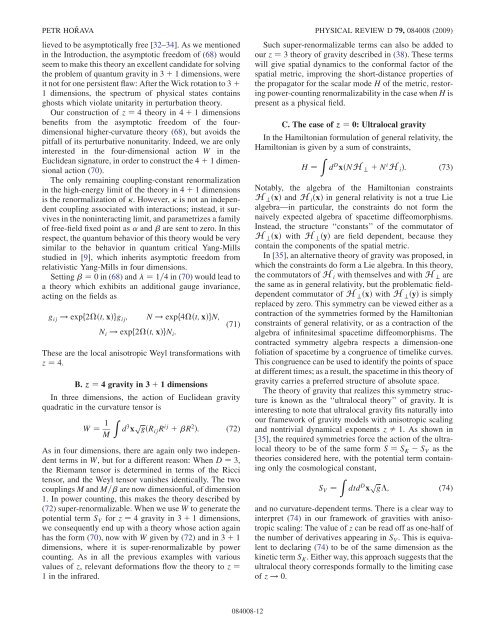Quantum gravity at a Lifshitz point
Quantum gravity at a Lifshitz point
Quantum gravity at a Lifshitz point
Create successful ePaper yourself
Turn your PDF publications into a flip-book with our unique Google optimized e-Paper software.
PETR HOŘAVA PHYSICAL REVIEW D 79, 084008 (2009)lieved to be asymptotically free [32–34]. As we mentionedin the Introduction, the asymptotic freedom of (68) wouldseem to make this theory an excellent candid<strong>at</strong>e for solvingthe problem of quantum <strong>gravity</strong> in 3 þ 1 dimensions, wereit not for one persistent flaw: After the Wick rot<strong>at</strong>ion to 3 þ1 dimensions, the spectrum of physical st<strong>at</strong>es containsghosts which viol<strong>at</strong>e unitarity in perturb<strong>at</strong>ion theory.Our construction of z ¼ 4 theory in 4 þ 1 dimensionsbenefits from the asymptotic freedom of the fourdimensionalhigher-curv<strong>at</strong>ure theory (68), but avoids thepitfall of its perturb<strong>at</strong>ive nonunitarity. Indeed, we are onlyinterested in the four-dimensional action W in theEuclidean sign<strong>at</strong>ure, in order to construct the 4 þ 1 dimensionalaction (70).The only remaining coupling-constant renormaliz<strong>at</strong>ionin the high-energy limit of the theory in 4 þ 1 dimensionsis the renormaliz<strong>at</strong>ion of . However, is not an independentcoupling associ<strong>at</strong>ed with interactions; instead, it survivesin the noninteracting limit, and parametrizes a familyof free-field fixed <strong>point</strong> as and are sent to zero. In thisrespect, the quantum behavior of this theory would be verysimilar to the behavior in quantum critical Yang-Millsstudied in [9], which inherits asymptotic freedom fromrel<strong>at</strong>ivistic Yang-Mills in four dimensions.Setting ¼ 0 in (68) and ¼ 1=4 in (70) would lead toa theory which exhibits an additional gauge invariance,acting on the fields asg ij ! expf2ðt; xÞgg ij ; N ! expf4ðt; xÞgN;N i ! expf2ðt; xÞgN i :(71)These are the local anisotropic Weyl transform<strong>at</strong>ions withz ¼ 4.B. z ¼ 4 <strong>gravity</strong> in 3 þ 1 dimensionsIn three dimensions, the action of Euclidean <strong>gravity</strong>quadr<strong>at</strong>ic in the curv<strong>at</strong>ure tensor isW ¼ 1 MZd 3 px ffiffiffi g ðRij R ij þ R 2 Þ: (72)As in four dimensions, there are again only two independentterms in W, but for a different reason: When D ¼ 3,the Riemann tensor is determined in terms of the Riccitensor, and the Weyl tensor vanishes identically. The twocouplings M and M= are now dimensionful, of dimension1. In power counting, this makes the theory described by(72) super-renormalizable. When we use W to gener<strong>at</strong>e thepotential term S V for z ¼ 4 <strong>gravity</strong> in 3 þ 1 dimensions,we consequently end up with a theory whose action againhas the form (70), now with W given by (72) and in 3 þ 1dimensions, where it is super-renormalizable by powercounting. As in all the previous examples with variousvalues of z, relevant deform<strong>at</strong>ions flow the theory to z ¼1 in the infrared.Such super-renormalizable terms can also be added toour z ¼ 3 theory of <strong>gravity</strong> described in (38). These termswill give sp<strong>at</strong>ial dynamics to the conformal factor of thesp<strong>at</strong>ial metric, improving the short-distance properties ofthe propag<strong>at</strong>or for the scalar mode H of the metric, restoringpower-counting renormalizability in the case when H ispresent as a physical field.C. The case of z ¼ 0: Ultralocal <strong>gravity</strong>In the Hamiltonian formul<strong>at</strong>ion of general rel<strong>at</strong>ivity, theHamiltonian is given by a sum of constraints,H ¼ Z d D xðNH ? þ N i H i Þ: (73)Notably, the algebra of the Hamiltonian constraintsH ? ðxÞ and H i ðxÞ in general rel<strong>at</strong>ivity is not a true Liealgebra—in particular, the constraints do not form thenaively expected algebra of spacetime diffeomorphisms.Instead, the structure ‘‘constants’’ of the commut<strong>at</strong>or ofH ? ðxÞ with H ? ðyÞ are field dependent, because theycontain the components of the sp<strong>at</strong>ial metric.In [35], an altern<strong>at</strong>ive theory of <strong>gravity</strong> was proposed, inwhich the constraints do form a Lie algebra. In this theory,the commut<strong>at</strong>ors of H i with themselves and with H ? arethe same as in general rel<strong>at</strong>ivity, but the problem<strong>at</strong>ic fielddependentcommut<strong>at</strong>or of H ? ðxÞ with H ? ðyÞ is simplyreplaced by zero. This symmetry can be viewed either as acontraction of the symmetries formed by the Hamiltonianconstraints of general rel<strong>at</strong>ivity, or as a contraction of thealgebra of infinitesimal spacetime diffeomorphisms. Thecontracted symmetry algebra respects a dimension-onefoli<strong>at</strong>ion of spacetime by a congruence of timelike curves.This congruence can be used to identify the <strong>point</strong>s of space<strong>at</strong> different times; as a result, the spacetime in this theory of<strong>gravity</strong> carries a preferred structure of absolute space.The theory of <strong>gravity</strong> th<strong>at</strong> realizes this symmetry structureis known as the ‘‘ultralocal theory’’ of <strong>gravity</strong>. It isinteresting to note th<strong>at</strong> ultralocal <strong>gravity</strong> fits n<strong>at</strong>urally intoour framework of <strong>gravity</strong> models with anisotropic scalingand nontrivial dynamical exponents z Þ 1. As shown in[35], the required symmetries force the action of the ultralocaltheory to be of the same form S ¼ S K S V as thetheories considered here, with the potential term containingonly the cosmological constant,S V ¼ Z dtd D px ffiffiffi g ; (74)and no curv<strong>at</strong>ure-dependent terms. There is a clear way tointerpret (74) in our framework of gravities with anisotropicscaling: The value of z can be read off as one-half ofthe number of deriv<strong>at</strong>ives appearing in S V . This is equivalentto declaring (74) to be of the same dimension as thekinetic term S K . Either way, this approach suggests th<strong>at</strong> theultralocal theory corresponds formally to the limiting caseof z ! 0.084008-12



![arXiv:1001.0993v1 [hep-ph] 6 Jan 2010](https://img.yumpu.com/51282177/1/190x245/arxiv10010993v1-hep-ph-6-jan-2010.jpg?quality=85)


![arXiv:1008.3907v2 [astro-ph.CO] 1 Nov 2011](https://img.yumpu.com/48909562/1/190x245/arxiv10083907v2-astro-phco-1-nov-2011.jpg?quality=85)







![arXiv:1002.4928v1 [gr-qc] 26 Feb 2010](https://img.yumpu.com/41209516/1/190x245/arxiv10024928v1-gr-qc-26-feb-2010.jpg?quality=85)
![arXiv:1206.2653v1 [astro-ph.CO] 12 Jun 2012](https://img.yumpu.com/39510078/1/190x245/arxiv12062653v1-astro-phco-12-jun-2012.jpg?quality=85)
